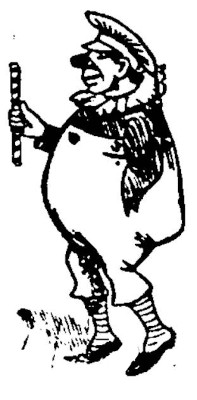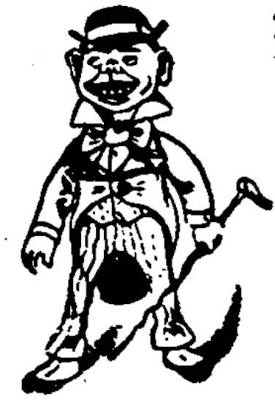This article has been transcribed from a copy of the Cardiff Times in the online collection of scanned Welsh newspapers 1804-1919 in the National Library of Wales, with grateful recognition of the free access accorded to all readers. A decorative initial has been added, and where necessary paragraph breaks have been introduced for easier reading. — David Skilton
Samuel has fun describing the familiar conventions of the pantomime, and in doing so he shows how much life there still is in the genre, tired though it may seem. He shows the link to Dickens (via Mrs Gamp), comic journalism (via Judy Magazine and the figure of Ally Sloper), and special theatrical effects (the Valentine transformation scene). It is clear that it is the very overfamiliarity of these things that is a major part of their appeal. Nevertheless Samuel seems thoroughly disillusioned about the whole business by the end of the aricle, and has lost much of his vitality. See the links after the article to Samuel’s other discussions of pantomime.

The Pantomime Author's Inspiration

s I told you in my few remarks on a pantomime rehearsal, sir, I am somewhat intimately acquainted with theatrical matters. For instance, I know something considerable relating to pantomimes, it having been my dire misfortune to write, or, rather, to ‘nail’ together, several entertainments of that class. But, though I am quite well acquainted with the elements of which modern pantomime is compounded, I really do not know what the latter is all about. It certainly, as a rule, tells no story; it burlesques nothing human, and assuredly nothing divine, and unless it be judged as the medium whereby a goodly proportion of the figures of a greater or smaller quantity of more or less (often less) presentable females is to be displayed, I don't know how to reckon it all up. It is often complained that pantomime authors suffer from many hardships; that when they write lines no one ever speaks them; and that they have in one and the same scene to introduce such incongruous ‘properties’ as an elephant, a stage coach, an Indian canoe, a balloon, a practicable pump, and a ‘trick’ mangle. But the pantomime author has many counterbalancing advantages in his favour.

But what I design to tell you about is the stereotyped dummies in the way of characters ever to be found in pantomime, no matter what the subject may be. Let us begin with the ‘principal boy.’ Custom anomalously dictates that the principal ‘boy’ shall be a girl — or, rather, any female on the bright side of sixty. This female must generally show as much of her figure as ever she decently can, and if she hasn't much, she must call art to her aid; she must wear a fair and most unnatural wig; she must sport an inane smile; she must simper and ogle like nothing in nature; she must, despite her forty-five years, we'll say, skip about (in order that people may say how full of ‘go’ she is), and if she has any shred of a voice (it is by no means always that she has), she must warble ditties, and must shuffle her lower extremities about more or less ungracefully (concluding with a good high kick and the bringing down of her heel violently on the boards), in the endeavour to persuade people that she is dancing. She must have at least two dresses -- one of the plain order to begin with, and one of a gaudily gorgeous character; she must talk slang; she must load her eyelashes with black and her cheeks with red, she must suddenly have the daylight represented in any given scene changed into lime-light — moonlight, in order that a disc of the latter may follow her about whilst she chants a lay about ‘the darling that she met beneath the moonbeams.’

The principal low comedian is generally cast as an ‘old woman’ (the mother of the hero), in order that all the pre-Adamite attempts at fun identified with the latter part may once more be trotted forth. If the comedian be an Irishman, the old woman is Mrs O' somebody or another; if he be a Scotchman he must be called Mrs Mac anybody you like. The stock in trade consists of two dresses, one very old and shabby, and short in the skirts — the other an ultra-fashionable ‘guy’ dress, with a parasol, and an enormous dress improver (this outside the dress if possible), which must be referred to as often as may be convenient -- this delicate joke being a sure card with the gallery. Other indispensable parts of the ‘old woman's’ cut-and-dried stock[-]in-trade are a bottle, which must be frequently produced in conjunction with jokes about ‘twopennyworths;’ a huge ‘gamp,’ much patched, a pair of gloves too long in the fingers, and a half-bald red wig of some kind. The bottle and ‘gamp’ are a sine qua non. Probably another of the low comedians will be a ‘silly-Billy’ sort of individual, of course dressed like a little boy of past times, with trousers buttoned over his waistcoat. Sometimes for this character is substituted one of eccentric nature, such as Ally Sloper, but these innovations are seldom thoroughly successful.

Of course there is a stereotyped villain, who is, in most cases, either a bold bad Baron, a wicked skipper, or an abominable Eastern potentate. But, whatsoever he may be, he is always ‘made up,’ with a hideous face, often with a trick wig, the hair of which rises when a string is pulled; he invariably has a pistol which will not go off (and down the barrel of which he whistles), a sword which refuses to be drawn from its scabbard, and a huge watch which he winds up with a bed-key. In ninety-nine cases out of a hundred, the band makes a hideous noise whenever he blows his nose, and if, in the judgment of the stage-manager, the pantomime has not sufficient of ‘go’ in it, the pantomimic villain [sic] is always provided with a bladder - well gilt - at the end of a stick, and with this he emphasises his remarks by bashing about the retainers near him. This original bit of fun will probably last as long as pantomime does. Considering what an amount of power he is supposed to wield, the other characters in the piece take the most unwarrantable liberties with the villain. Two or more music-hall personages, who have only about three lines (which they found much difficulty in learning) of the author to speak, are, as a rule, worked in as the villain's principal ‘myrmidons.’ They do nothing in particular till their own special ‘front’ scene comes on, when they (whilst the elaborate back scene behind is being set) kick one another under the chin, do a song and dance, and then knock each other about again as they do in their native music-halls. Another character -- who has now become fairly stereotyped -- has been introduced of late years. This is the local, countrified part — the man who paints his face very red, speaks in the vernacular, chuckles a great deal, and makes local allusions. This personage is highly popular with the intelligent countrified ‘tripper’ class. Then amongst the ladies, who are cut to a pattern, there is ‘the principal girl;’ she is not unfrequently getting on in years, and when the hero makes gushing love to her and calls her a ‘chick’ or addresses some other endearing term to her, the effect is infinitely delightful.

What I wish to imply by all this, sir, is that those people who do the most conventional and stereotyped things in a perfectly matter of fact manner get far more praise both from the press and the public, and far more pay, in proportion, than they deserve. The artist and the author and the journalist are inventing and creating novelties week after week, year after year, whilst the two highly paid performers of pantomime go on for weeks at a stretch and in a dozen consecutive pantomimes doing the same nauseatingly ancient business, most of which has not even been invented by themselves, but handed down to them from a previous generation of performers. Everything in a pantomime, sir, from the demon to the leering danseuse and the frequently cheap, valentine-like transformation scene, is absolutely old and conventional, and you can this year see the same dejectedly funny business repeated in two-thirds of the theatres.
Links to Related Material
- Samuel attends a Pantomime Rehearsal
- Samuel on the Drama of Legs (coming soon)
- Samuel on Pantomimes (coming soon)
Last modified 22 October 2021